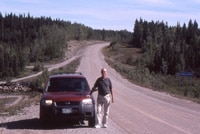For much of last year, archivist Ted Wickson was deep in residential schools research. He sorted through stacks of documents in the General Synod Archives and wrote up individual histories of all schools run by the Anglican Church of Canada. Full of these facts, Mr. Wickson was inspired to spend his summer vacation travelling to former school sites.

“I studied the schools in an armchair manner, looking at photos and reading records,” he said in a later interview. “But I also just like to see the sites. When you’re standing there you can take a moment and pause and just reflect on what took place there.”
So Mr. Wickson went out on the road. Between July 25 and August 24, he visited around 18 of the 36 confirmed sites, driving over 15,000 kilometres, mostly solo in his Ford SUV. From Toronto he went north up to Moosonee, over to Manitoba, Saskatchewan, and Alberta, up to the Northwest Territories, then back down south of Calgary before jogging back through the prairies
Luckily, all of his minor driving mishaps (a stone in the brake cylinder, a flat tire) happened close to civilization. “There is no CAA north of 60, so you have to keep those things in mind,” he said with a grin.
This being a kind of casual, personal trip, Mr. Wickson made no prior arrangements for tours; he would simply head out with his camera to find old buildings, often the churches, barns, or cemeteries linked to residential schools. “I was able to picture archival images in my mind when I was on the site, so I knew where things were,” he said.
He found the schools in many different states: converted to Aboriginal-run colleges, cultural centres, or razed.
At the Pas, Man., Mr. Wickson travelled to see a school destroyed by fire in the 1930s. It had been built on an island, so he photographed from the shore of the Saskatchewan River. As dusk settled, the nearby Opaskwayak Nation was hosting a pow-wow within earshot. Mr. Wickson described it as “quite a moving time of reflection as the sound of drum and dancing could be clearly heard in the night air.”
When Mr. Wickson did meet people, they often were surprised by his mission. In an email update to General Synod, he wrote, “On the arrival at Lac La Ronge [Sask.] I went to the visitors’ centre…to get a lay of the land, to get a local map and there was a Cree elder there who talked to me and she was really surprised about my task, my interest, and I gave her the histories…she then in return directed me to the [residential school] site.”
In Cluny, Alta., Mr. Wickson ran into Archdeacon Sidney Black, co-chair of the Anglican Council of Indigenous Peoples and a member of the north Blackfoot nation. He directed Mr. Wickson to certain school sites—one of many encounters that filled research gaps.
Mr. Wickson noted, however, that when speaking to people, he focused on the basic facts of the schools, and did not attempt to provide pastoral or spiritual support. On his trip he heard many reactions to the residential school experience, including stories of former students being denied compensation by the Canadian government because there were no records of their attendance.
Mr. Wickson, who has worked on contract for General Synod, will now pass along his trip photos to the church’s archives. They may also be used by the Truth and Reconciliation Commission. As for the school histories he worked on, they will soon be available on General Synod’s residential schools website.
“The trip was very satisfying,” he said. “One of the more interesting vacations I’ve taken.”
Interested in keeping up-to-date on news, opinion, events and resources from the Anglican Church of Canada? Sign up for our email alerts .
